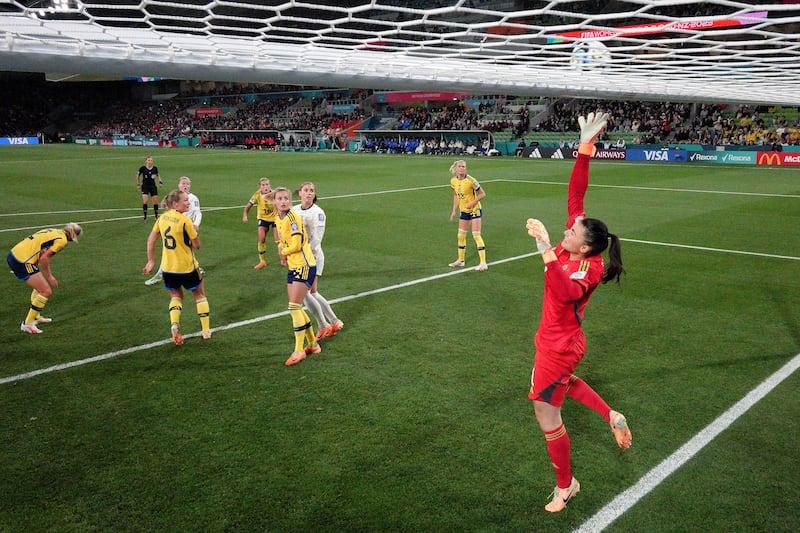So, after 62 matches, we are down to the final two at this Women’s World Cup: Australia v Sweden in the third-place playoff, and the final between Spain against England. Throughout the tournament, we have been looking for storylines, tactics and trying to decipher what will separate the best from the rest. For a few of us, including Cork City Women’s goalkeeping coach James Goodwin, the netminders are usually the deciding factor.
Goodwin, like myself and many others, was anxious for the goalies. One of the sticks used to beat women’s football has always been the quality of goalkeeping. Hop on YouTube and watch the reels and comment along with all the sad people who fail to apply context when a goalkeeper fails spectacularly.
But this World Cup has been different, with Sweden’s Zecira Musovic being the standout player. But goalkeepers – and particularly the attention they are getting from coaches – have driven that standard exponentially, as Goodwin explains.
“The goalkeepers we have in Cork City Women, they all have gym programmes, they’re all working on their strength and conditioning and that’s making them more explosive, I guess, which would come into the plyometrics side of it,” he says.
READ MORE
Goalkeeping training is no longer just running around a pitch, or having people fire shots at you
“And perhaps box jumps and things like that. So I would do that in the gym. When we’re out on the pitch, there’s an awful lot of footwork, a lot of moving quickly across the goal, perhaps multiple saves as well.
“So getting down to make a save and then subsequently getting up to make perhaps one or two more saves, and you might make a save on the floor and then a high catch is just getting the physical strength in the lower body. That is really important in the women’s game, I think even more so than the men’s game.”
The physical differences between men and women in goals are obvious. The average height at this women’s World Cup for goalkeepers is 5ft 8in (173cm), while the average height in Qatar at the men’s World Cup was 6ft 2in (188cm). The goals remain the same size for both, but that doesn’t necessarily mean there’s an immediate disadvantage, especially with more goalkeeper-specific coaching being utilised.
“I think there are certainly different challenges there,” says Goodwin. “But there are obviously different capabilities physically, between boys and girls. That’s that, so you have to work on different things. You find yourself prioritising different areas of training, particularly around reactions, and perhaps footwork because obviously the goals are the same size and the individuals are not necessarily the same size.
“So that’s something we look at. But just in terms of the difference between the two, the underage boys and the girls I work with are very much on a similar level technically. It’s just things like physical strength that come into play, and perhaps height. Those would be the differences.”
Even with the explosiveness of the shots that goalkeepers have to face, reaction time is huge. The USA’s Lindsey Horan blasted a shot at Sweden’s Musovic that recorded a travelling speed of over 90kmph. Even more impressive was how late Musovic saw the shot as the ball curled around bodies.

Goodwin explains that’s mainly down to training techniques.
“We work with a lot of hurdles and box-jumping to help with explosive jumps: short, sharp stuff, lots of diving, as you’d expect from a goalkeeper. It’s no longer just running around a pitch, or having people fire shots at you.
“In terms of goalkeeper coaching, we work much more with the same defensive unit and building up and even defending what you might have for defenders in front of you. And we do crossing and shooting. But there’s a whole lot more to it than just having balls fired at you into the goal and practice there was a few years ago.
“What I would say is, I think lots of goalkeepers probably haven’t received specific goalkeeper training over the years, and if they have, it tends to be later for girls and boys. So I think where we’re going to improve is perhaps by starting them younger, and just really getting young girls at an earlier age.
“And I think the World Cup will really boost this in terms of getting girls in at six and seven, and getting good coaching and then a follow-on from that as you want investment into the women’s game as well.”
[ England reach World Cup final for first time with victory over hosts AustraliaOpens in new window ]
There is also an increased reliance on the data, and from a Cork City perspective they can see where attacks stem from, which wings crosses are whipped in from, who’ll have a snap-shot and who’ll collect the ball during scuffles to smash it in.
But more important than ever is how a goalkeeper works with her backline. Cata Coll of Spain and Mary Earps of England consistently start their teams off in attack, providing an outlet for their defenders who are under pressure and becoming more confident with their feet.
“I think if you look at the percentage of what a goalkeeper does in each area of the game, I think shot-stopping is probably less than 10 per cent of it now,” says Goodwin, “whereas distribution, and I’m reluctant to give you a figure, but it’s very high.
There are obviously different capabilities, physically, between boys and girls. That’s that, so you have to work on different things
“We have to take into account in the training we do, we’ll build in playing out from the back, we would bring in defenders and perhaps a defensive midfielder and then more players, there would be a huge amount of focus on that.
“As goalkeepers, we’re not just tucked away in the corner for the session, as you might have seen and been in times gone by I guess. Now we’re very much an intrinsic part of the team, and do everything together in that respect to this building up from the back.”
Of course, mental resilience is the final factor in being a goalkeeper. Goodwin admits that sometimes you just have to move on when things go wrong. Some smile, some kick the goalposts, some wipe the sweat from their brow. It’s the loneliest position and one for those who are most resilient, a skill that can be learned.
Goalkeeping is a vital position. Coll and Earps will show us just why in the World Cup final on Sunday.


















